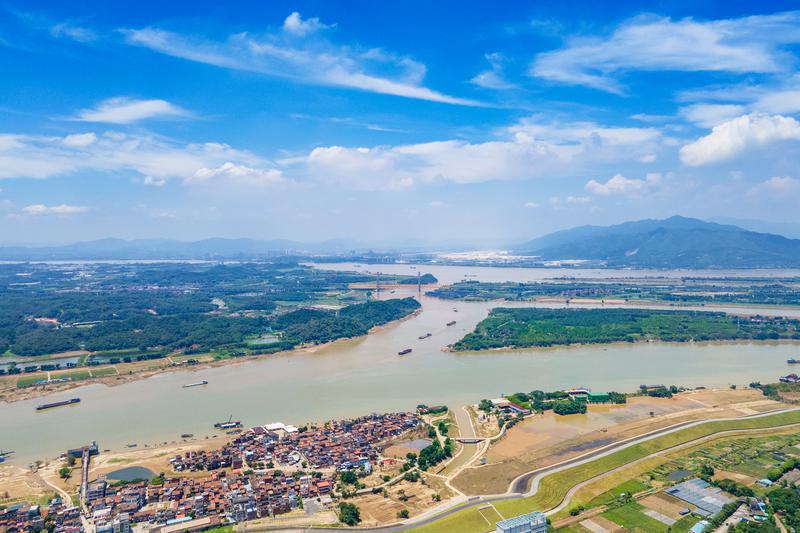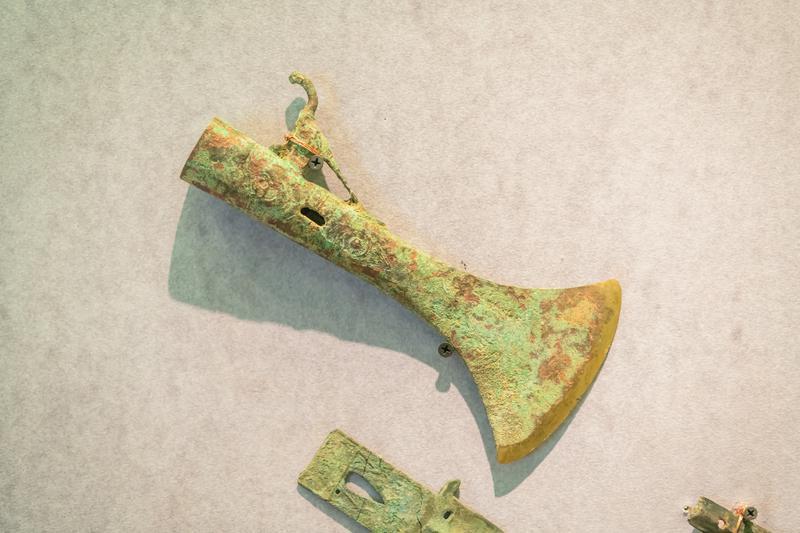Humanities Sanjiang | Yanyun turbulent Banjiang Bridge: any door to historical space -time
Author:Foshan Daily Time:2022.07.23

In the era of mobile phone reading, Sanshui, which has the shape of Sanjiang Connect, is a city suitable for horizontal viewing. We gently "open" the Banjiang Bridge located in the Hekou community in the Southwest Street, and we can find a "folding" space -time.

From the river mouth area of the southwest street of Sanshui District, overlook the flow of Sanjiang. Photo by Wang Yan, a reporter from Foshan Daily
Banjiang Bridge, like a show pen, pointing to Jiang Xin. With it as the heart, within about 3 kilometers of the square, it is the only thing in the old county relics, the only 36 Jiangjiang Tower, the Sixian Tower of Chen Baisha, and the Kundu of Kundu, who are here in Chen Baisha. Mountain, Jin Yong wrote the "Three Water Wars" of "Lu Ding Ji", as well as the customs building and Guangsan Railway site that the Sanshui and modern civilizations were first embraced with modern civilization a hundred years ago ...
Why is the soldier that must fight? How bustling Banjiang Bridge? Any door for the memory of the old city has been opened in front of us.

It is located in the Banjiang Bridge in the estuary area of the southwest street of Sanshui District. Photo by Wang Yan, a reporter from Foshan Daily
Battleground:
Mirror Jiannan's death
Seeing the famous city of the battlefield, the dangerous egg defeated South Xinjiang -this is the first password to open any door. These fourteen words are from one of Yu Dafu's "The Miscellaneous Poems". Sanshuihekou, who can afford the mighty soldiers in this poem to kill.
In this waters with the Banjiang Bridge as the dot, the ancient battlefield was everywhere. During the Tang and Song dynasties, the court had sent sailors to set up a camp under the Kundu Mountain on the other side. On the occasion of the Yi Dai of the Ming and Qing Dynasties, Nanming's "Tang Guizhi's dispute" broke out here, and the forces such as Li Dingguo, Li Dingguo, and the Pingnan King of Pingnan, and other parties were competing here.
Born in the Banjiang Bridge in 1936, it was born with the illegal vitality since ancient times. It is said that the reason why the Banjiang Bridge was built was due to military struggles. At that time, Yu Hanmou, the commander of the Fourth Road Army of Guangdong, allocated 200,000 yuan to build the River Estuary Military Bridge. It was planned to be a military movement. The Banjiang Bridge was a reinforced concrete structure with a width of 3.8 meters and a length of 237.5 meters. The southwest extends to Jiangxin.
Later, the situation changed, and the Banjiang Bridge had not played a large military use after completion. Later, the Banjiang Bridge became a bridge for the benefit of the people -one end of its Jiangxin built a three -layer dock. When the water rose, it could go from the Banjiang Bridge to board the ship.
However, in this waters, there have been a seemingly small but far -reaching battle. That is, on November 29th in the three years of Shunzhi (1646), the "three waters of the Sanshui" broke out between the two regimes of Gui Gui and Tang Wang.
According to the "Sanshui County Chronicle", King Gui Gui and Tang King Tang for the emperor, and the two troops broke out in the west of Sanshui County. The King of Gui was defeated by the Tang King's army, and more than 800 people were killed. However, the victory of the Tang King was not happy for too long, and was led Li Chengdong to lead Guangzhou by the general of the Qing general. "Tang Gui's dispute" directly led to the fall of Guangzhou, and Zhu Youlang, who was far away from Zhaoqing, escaped and fled under the pursuit of Li Chengdong. Soon it was broken by Li Chengdong, and Guangdong lost. "Tang Gui's dispute" will restore the hope of the Central Plains again.
This paragraph of Nanming was also included in the ninth round of "Lu Ding Ji" by Jin Yong. The acquaintances and disputes between the brothers of the heaven and earth Xu Tianchuan and Mu Wangfu Bai Hanchang and Bai Hanfeng were slowly brought out. Originally, the Tiandi Association and Mu Wangfu both took the banner of resisting Qing Fu Ming. When the three conspired to resist the Qing and put the wine, they had a heart of heart because they were "supporting the Tang Dynasty" or "supporting the laurel", and even fought.
Since ancient times, the soldiers must fight, or a historical city, or a natural danger, or a transportation hub. The trend of fate sometimes depends on whether it can hold these important passage. These factors are obviously not available, and even in history, Sanshuihekou has never had a famous battle in the first battle, but in literature, it is fortunate, but only by a historical accident, Jin Yong has since incorporated Jin Yong’s. The martial arts world, becoming the corner of the tens of literary treasures:
For example, Fengling Ferry, it was Guo Xiang's mistakes at first sight; like Xiangyang City, that was the big of Guo Jingxia for the country and the people. The Sanshuihekou was alerting future generations with "Tang Gui's dispute", and Jing Jiannan's death.
The port is open to the world:
The ancestors embraced the world
Look at Wu Gou, take a railing -this is the second string of passwords that open any door. These nine words are from Xin Qiji's "Shuilong Yin · Deng Jian Kangxin Pavilion". The Sanshui and River estuary engraved with the humiliation and strength of an era.
Following the Banjiang Bridge, let's retract our horizons from the time and space of history to reality. At the other end of the bridge, there is one of the witnesses of Sanshui embrace modern civilization -the oldest post office in Foshan. It is dozens of meters away from the post office, which is the oldest customs building in Guangdong. About one kilometer away from the customs building is the oldest railway station in Guangdong. They were born more than a hundred years ago. At that time, it was in the early 20th century. The Qing Dynasty, which was established for nearly 300 years, was already the building.

A century -old customs building located in Hekou District, Southwest Street, Sanshui District. Photo by Wang Yan, a reporter from Foshan Daily
Thirteen years after the outbreak of the Sino -French war broke out in the 23rd year of Guangxu (1897), the British forced the Qing government to sign the "Sino -British Renewal Myanmar Treaty". Consulate and customs. In the same year, the British set up the Sanshui Customs and Taxation Department of the Sanshui Customs and Taxation of Sanshui Old County to implement the semi -colonial customs customs administrative and personnel system of foreign tax departments. Tariffs were owned by the UK. In 1909, the old customs building of Sanshui was established, and the century -old customs building has witnessed the humiliation history that China has become a semi -feudal and semi -colony. Under the humiliation, Sanshuihekou wrote history with a strong position:
In November of the 25th year of Guangxu (1899), the court officially opened the second -class post office in Sanshui, with 6 postman. At the time of the establishment, the Sanshui Old Post Office was located outside the south gate of the county seat. In 1920, it moved to the current position -the starting point of the Banjiang Bridge, and there were 9 agencies and 3 letters. Later, convenient water and land transportation made the old post office of the estuary an important postal transit station.
In the 27th year of Guangxu (1901), the Guangsan Railway was officially built. The Guangsan Railway from Shiwei Tong, Guangzhou to Sanshui River, with a total length of 48.9 kilometers. Two years later, it was opened to traffic. It is the first railway to traffic in Guangdong.
Native
Sanshui hugs modern civilization. "Sanshui County Chronicle" records that after the opening of the Sanshuihekou port, it quickly became an important transportation hub and cargo transfer center in the Northwest River Basin. There are often warships and merchant ships such as Britain, the United States, and Japan. Western fire, kerosene, and cloth from foreign countries come in and out of the local silk, tea, peanut oil, textile soil cloth and other products from the native. With the connection of the Guangsan Railway with the West and Beijiang Shipping, this "water -rail transportation" model makes it even more to make it even more than Hekou has become a bridgehead that communicates Guangzhou, northern Guangdong, western Guangdong, and even southwest of China. Later, Banjiang Bridge also became a large -scale shipwreck. Past vessels could be parked and loaded and unloaded goods here. It is said that the grandfather of the national capitalist Rong Yiren sent a home from Hekou. Rong Yiren's grandfather Rong Xitai and his father Rong Desheng have served at the Sanshuihekou Gold Bureau (equivalent to the Taxation Bureau). Today, Rong Xitai and Rong De Sheng were still well preserved in the old house rented in Hekou.
The world also opened a window to understand China. For example, the Kuangwen Pagoda outside Hekou City was not only printed on a postcard sent by the Guangsan Railway Station in 1905, but also appeared in "Lingnan Jisheng" compiled by Japanese Kiyoshi Taro. In the book "The Three Water in the Eyes of the British", a photo of the gathered records recorded in the estuary port of Kawaguchi Port was included. Carry out the remote and distant mountain areas such as kerosene, salt, and groceries. "
The Kawaguchi Ancient Weapon Exhibition Hall in the Centennial Railway Station theme park of Sanshuihekou exhibited more than 100 weapons from the pre -Qin Dynasty to the Qing Dynasty. Town Hall Treasure ".

The estuary more than a hundred years ago, a sound telegram, a sealing email, and a whistle from here, recorded how Sanshui was passively connected to the world, and how the ancestors set out from here and moved to ocean.
Today, more than a hundred years later, starting along the Banjiang Bridge, these ancient buildings are silent, but they have labeling one by one in the space and space of history, so that the pictures of a hundred years ago, the story of 100 years ago, there are traces of the story. Can follow, never forget.
Text/ Foshan Daily reporter Yang Liyun
Figure/ Foshan Daily reporter Wang Yan
- END -
The Ping An Office of Boxing Street promotes the "nine small places" in the jurisdiction in an orderly manner

In order to accurately implement the prevention and control policies of the epidem...
Retired soldiers in Lintong District drove \"love to send test car\"

\Hello, our school has six candidates who have long rented in Jiabao Village for...